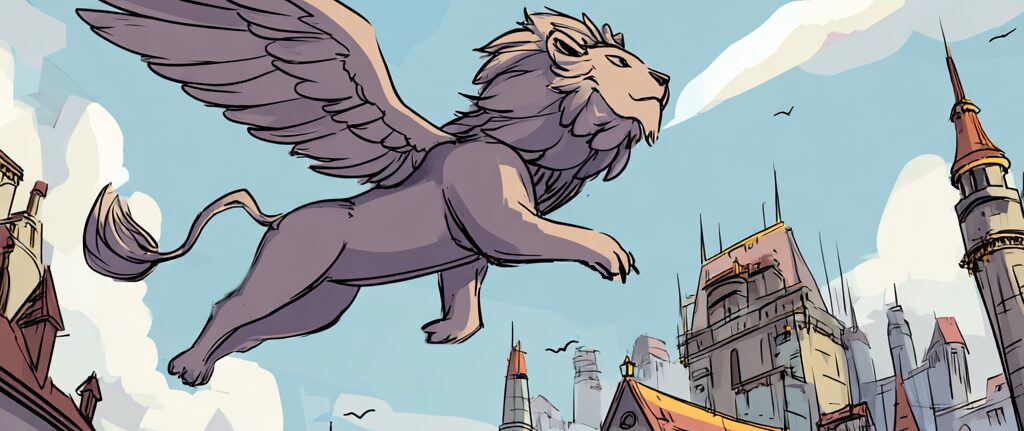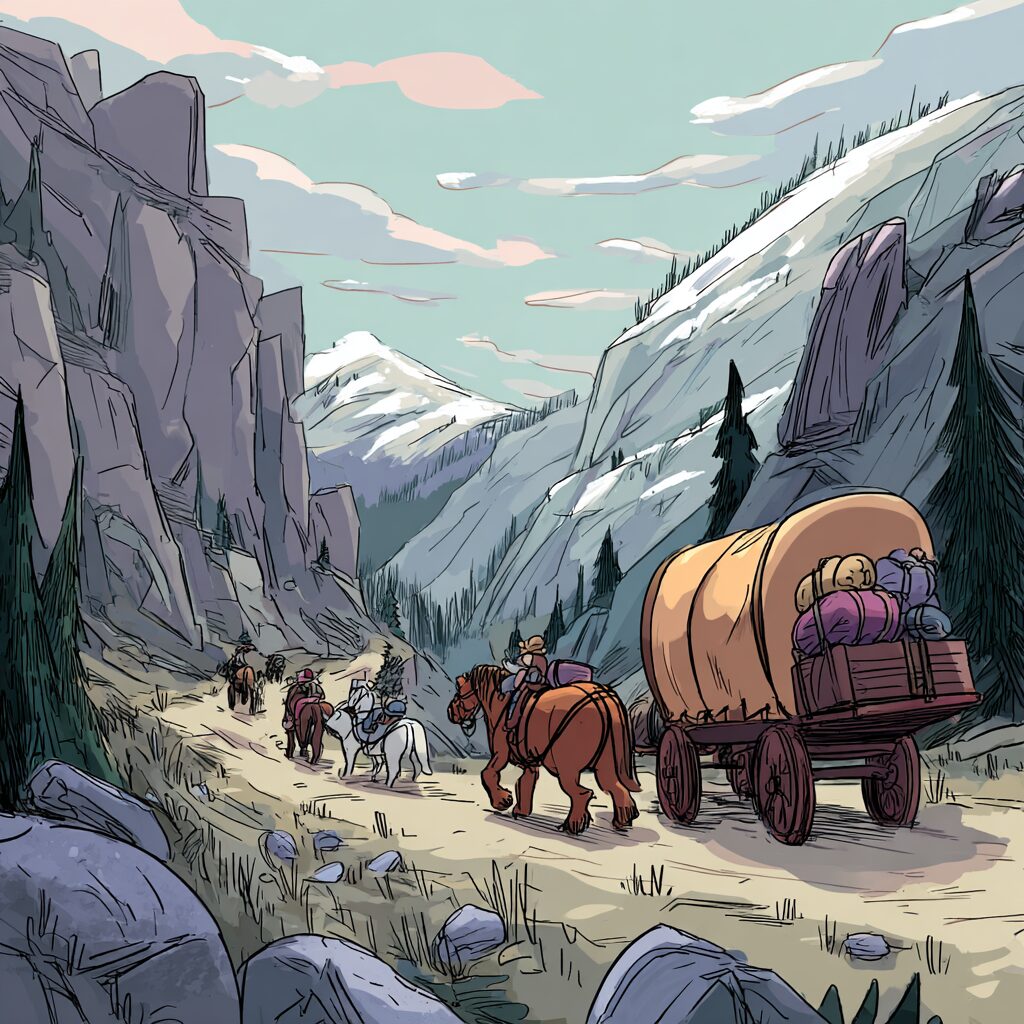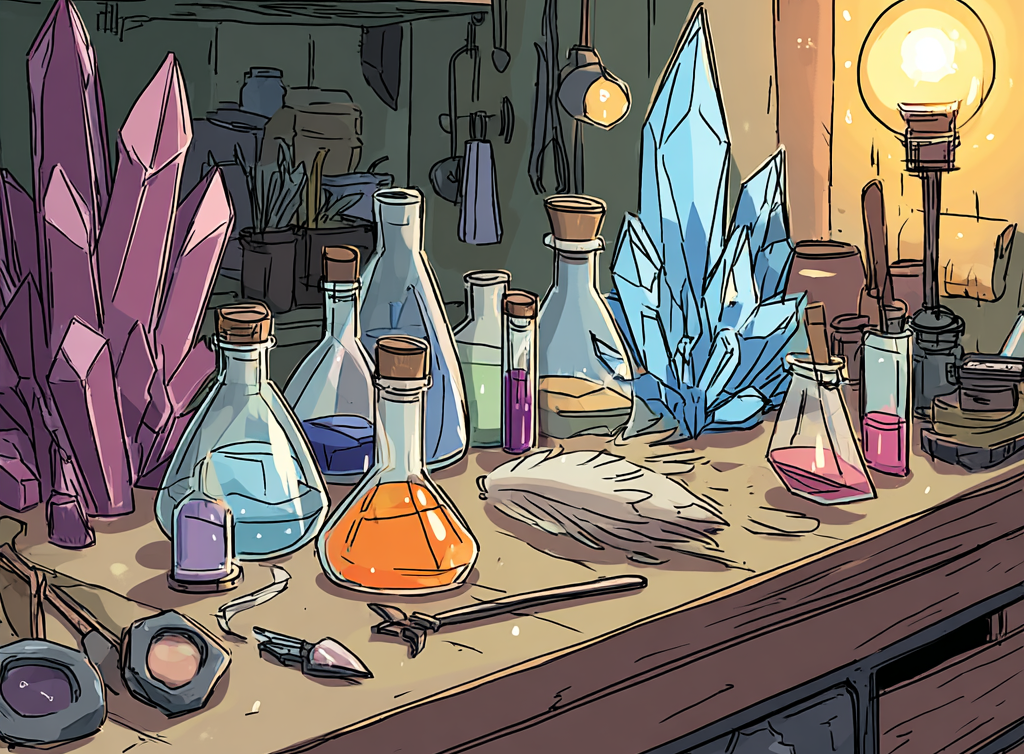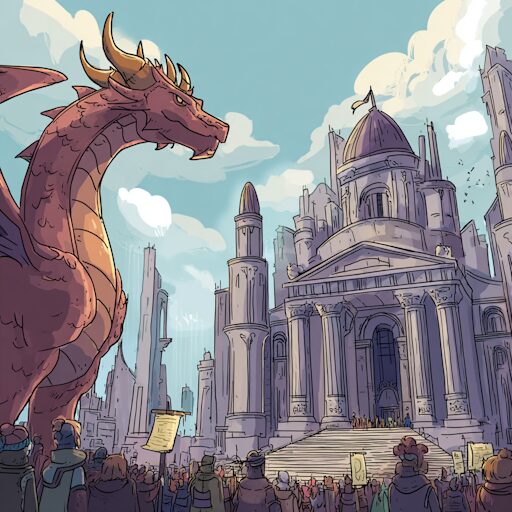The Economy of the Griffon
Where gold takes wing, and a 500-pound lion-eagle becomes your best business partner

What happens when a creature that can carry half a ton over mountain ranges in hours disrupts trade routes that took centuries to establish? The griffon isn’t just about moving goods—it’s about reshaping civilization, one flight at a time.
—By Aldric Dwarden, Former Royal Advisor to the Crown
When Young Money Meets Old Money (And Old Money Loses)
“You have to understand, Master Aldric,” the young merchant’s voice trembled as he clutched his ledger like a shield, “Ironhold controls the only viable trade route through the Dragonspine Mountains. Their caravans take six weeks, their fees are ruinous, and they demand exclusive contracts. But if what you say is true about griffons…”
I leaned back in my chair, studying Korvain Goldstorm—third son of minor nobility, ambitious enough to risk his inheritance on revolutionary transport, yet naive enough to think griffon economics were as simple as “buy bird, make money.” Behind him, through the large windows of my counting house, I could see three of my own aerial steeds roosting on their tower perches, their eagle eyes scanning the sky for something tasty…
“Young Master Goldstorm,” I said carefully, “what I’m about to tell you will either make your fortune or bankrupt your family faster than an eagle diving for prey. The griffon trade isn’t merely about moving goods from point A to point B—it’s about taking a centuries-old trading system and throwing it off a very tall cliff.”
I had learned this lesson the hard way, twenty-three years ago, when I watched the guilds crumble before the advent of aerial commerce like a poorly built tower in a windstorm. Those who adapted grew wealthy beyond imagination. Those who didn’t… well, let’s just say the Merchant’s Quarter still has some very grand, very empty halls where stubborn old fools used to count their rapidly diminishing gold.
How Lady Brightfeather Broke an Empire (With Birdseed and Audacity)
The transformation began, as many revolutions do, with a single desperate gamble and a woman who refused to accept that “we’ve always done it this way” was a valid business strategy. Lady Thessa Brightfeather, facing bankruptcy after bandits destroyed her fourth caravan in as many months, made an arrangement with a few druids and wild griffons nesting in the Thunderpeak Range that would make merchants weep with either joy or terror.
What started as a simple agreement—fresh meat and sovereignty of a small, wooded glade, in exchange for carrying small, valuable parcels—became the foundation of an industry that now moves thousands of gold pieces worth of goods. More than some kingdoms see in their entire treasury, and it all started because one woman decided that flying predators might make better business partners than an adventuring party.
The traditional merchants didn’t take the threat seriously at first. How could they? For centuries, overland trade had followed predictable patterns as reliable as sunrise: heavy wagons creaking slowly along established routes, protected by hired guards who charged extra for staying awake, paying tolls at every checkpoint where some minor noble’s cousin needed beer money, paying bribes to local extortionists and accepting losses as part of doing business the way one accepts bad weather—inevitable and expensive.
The infrastructure was enormous—roads that cost money to maintain, travelers inns that served ale slightly worse than horse urine, repair shops run by smiths who could fix a broken axle but couldn’t count past their own fingers, and guard companies with impressive armor and questionable courage, or the even worse alternative to guards: adventuring parties.
Griffons changed everything.
“Impossible!” declared Guildmaster Rothgar Ironhold when Lady Thessa’s aerial courier delivered a crate of ethereal silk from the coast to the mountain city of Skyhold in three days—a journey that previously took his caravans five weeks and at least two nervous breakdowns. “No flying beast can carry meaningful cargo! This is some sort of trick!”
Within two years, Ironhold’s monopoly was broken like an egg dropped from eagle-nest-height. Within five, half the traditional overland freight companies had either started paying Lady Thessa or vanished entirely, leaving behind only empty warehouses and very bitter former guildmasters. Today, Rothgar’s son begs me for griffon breeding contracts while wearing the expression of a man who’s realized his father’s “impossible” prediction aged about as well as milk in summer.
Meanwhile, Lady Thessa’s Sky Merchant Guild controls trade routes spanning three kingdoms and has enough political influence to make kings reconsider their dinner plans.
The lesson? In commerce, altitude equals attitude—and griffons gave traders the ultimate high ground, (*ahem*, pardon the puns).
Why Griffons Are Disruptive
Understanding this requires grasping three fundamental advantages that make mythical creatures the fantasy equivalent of the internet disrupting traditional retail—except with more claws and a tendency to eat halflings whole.
Route Independence: The Death of Chokepoints
Griffons don’t need roads, which is perhaps the most revolutionary concept in trade since someone figured out that coins were more convenient than bartering chickens. This eliminates economic chokepoints that previously allowed regional monopolies to flourish like mushrooms in damp caves.
When Lady Thessa could fly directly from coastal ports to mountain mining towns, she bypassed six different toll stations, three guild checkpoints, and the infamous Bandit’s Gorge—saving both time and the protection fees that traditionally consumed 30% of cargo value. Suddenly, every mountain valley became as accessible as every coastal port, and geography stopped being destiny for ambitious merchants.
Cargo Capacity: Quality Over Quantity
A griffon’s carrying capacity is substantial—540 pounds for a full-grown male (DMs Note – for the rules-lawyers reading this thats 30 lbs for a large creature, times the 18 strength of a griffon, going by straight 5th edition SRD), thanks to the impressive strength that comes from being essentially a flying lion with an eagle’s head and a predator’s attitude. However, this constraint requires strategic thinking rather than the “load everything that fits” approach of traditional wagons.
The magic happens with high-value, moderate-weight goods that were previously uneconomical to transport. I’ve witnessed single griffon flights carrying:
- Spell components worth 2,000 gold pieces weighing only 50 pounds (profit margin: extraordinary)
- Masterwork jewelry generating 5,000 gold pieces in profit from a 200-pound cargo load (ROI: ridiculous)
- Diplomatic correspondence needing speedy delivery worth kingdoms and weighing mere ounces (value: incalculable)
- Poison supplies creating 9,000 gold pieces profit from a 300-pound shipment (markup: shameful but that’s what you can get with illegal goods)
Weather Mastery: When Storms Become Opportunities
While ground caravans halt for storms like frightened children hiding under blankets, griffons can use some weather to their advantage with the confidence of apex predators who consider themselves part of the sky itself.
A skilled griffon rider can leverage wind currents to increase speeds, while storm clouds provide concealment from both aerial pirates and ground-based observers with more curiosity than good sense. My most profitable run ever involved delivering emergency supplies during a blizzard that had every road impassable—the client paid eight times the normal rate for food that arrived when no other transport could move, proving that sometimes the best business opportunities come disguised as terrible weather.
The True Cost of Flying High: Griffon Acquisition Economics
The first question every aspiring aerial merchant asks is: “How much for a griffon?” which is roughly equivalent to asking “How much for a small kingdom?” The answer isn’t simple, because griffons aren’t commodities you can order from a catalog—they’re business partners with voracious dietary requirements (and a tendency to eat things they shouldn’t).
Initial Investment: More Than Your Village’s Annual GDP
Acquisition Costs That Will Make Your Accountant Weep:
Its hard to capture wild griffons, let alone train them. Its high risk, high reward, with a moderate chance of being eaten. Only the strangely lucky would come across a domestically bred griffon for sale (and do check the paperwork, there’s bound to be a lineage or other problem), let alone a breeding pair.
Infrastructure: Building a Sky Castle
Essential Facilities (Because Griffons Are Particular About Their Accommodations):
You need proper aerie construction – think luxury penthouse with a landing strip, not to mention feeding facilities with prey storage. You’ll also want security measures (griffon theft is surprisingly common – you will need something that keeps your average adventuring party well away).
Operating Costs: The Price of Excellence
Annual Expenses That Never Stop:
There’s also daily feeding (fresh meat – and griffons have expensive tastes), veterinary care, handler salaries (skilled labor and danger pay).
I quoted Master Goldstorm some of these figures, and his face went pale as fresh parchment. “Those costs… they’re astronomical!”
“Yes,” I agreed with the patience of someone who’d had this conversation hundreds of times, “but consider the returns. A well-managed griffon can generate tens of thousands of gold pieces annually in freight revenue. Factor in the speed advantage, route flexibility, and premium pricing for aerial delivery, and most operators see full investment recovery within three to five years—assuming you don’t do anything dramatically stupid…”
Training: Teaching Lions to Fly for Money
The most overlooked cost in griffon commerce is training—both for the creatures and their human partners. This isn’t like teaching a horse to pull a cart; this is like teaching a flying apex predator to become a commercial airline pilot despite their anger management issues. Also, teaching humans to Not Fall Off is actually pretty hard – your average drunken wagon driver isn’t going to last long in the skies.
Regional Economics: How Griffons Reshape Regions
Griffon commerce doesn’t just move goods—it reshapes trade itself.
Example: The isolated Northlands Transformation
Before aerial trade, the isolated mountain settlement of Frostholm survived on subsistence agriculture and limited mining, connected to the outside world by seasonal pack trains that arrived with the reliability of snowfall—unpredictable and often disappointing. Transportation costs made importing goods prohibitively expensive, while exporting their excellent silver was barely profitable after caravan expenses ate most of the margin.

Griffon freight changed everything faster than a mountain avalanche. Suddenly, Frostholm could import luxury goods economically while exporting their silver at profit margins that made their miners dance jigs in the snow. The town’s population doubled in five years, property values tripled, and new businesses emerged to serve the growing prosperity like flowers after a spring rain.
However, the transformation wasn’t without casualties. Many traditional pack train operators lost their livelihoods, and the old merchant families who had controlled ground-based trade found their influence dramatically reduced. Some adapted; others spent their remaining wealth on increasingly cheaper alcohol.
Territorial Disputes: Drawing Lines in Empty Air
Unlike roads, which follow established boundaries marked by conveniently placed stones and occasional guard posts, aerial routes cross territories with the casual disregard of creatures that consider national borders merely suggestions.
I’ve mediated dozens of disputes between nobles claiming “air rights” over their lands and griffon operators insisting on flight path freedom with the determination of merchants who’ve discovered profitable routes. Generally during negotiations I can get them to follows these simple principles:
- Flight below 500 feet requires territorial permission (usually a bribe helps)
- Emergency landings are permitted anywhere with compensation for damages (ok yes, these are usually very expensive)
- Military airspace restrictions apply during conflicts (and are likely enforced with crossbows)
- Sacred or ceremonial areas may have permanent flight restrictions (violate these at your own risk)
Learning from Real History: The Suez Canal Parallel
There are lots of historical parallels to griffon commerce – one comes from studying the Suez Canal’s completion in 1869—a real-world example of how new transportation technology can reshape economics.
Before the Canal: The Long Way Around
European trade with Asia required the lengthy voyage around Africa’s Cape of Good Hope—over 11,000 miles that took months to complete and enough supplies to feed a small army. This route was controlled by established shipping companies with the resources to maintain such extended operations, creating natural monopolies because of the capital requirements and operational expertise needed to make that long trek.
The Disruption: Cutting Through the Impossible
The Suez Canal reduced the journey to Asia by almost half (40%). Suddenly, smaller operators with less capital could compete in international trade, while established companies found their expensive infrastructure and long-term contracts about as valuable as ice in a desert.
Economic Transformation: Winners and Losers
Within a decade, global trade patterns had fundamentally shifted. British trade with India increased by 30%, while traditional maritime powers like Portugal found their historical advantages reduced.
New shipping companies emerged, while some old-established firms faced bankruptcy or forced consolidation, proving that in commerce, adaptation beats tradition every time.
The Underground Economy: When Good Birds Go Bad
High-value aerial transport inevitably attracts illegal activity like honey attracts bears—with similar levels of danger and profitability for those willing to risk the consequences.
The aerial advantage makes smuggling detection difficult—it’s much harder to inspect a griffon at altitude than a wagon at a checkpoint, assuming you can catch the griffon in the first place.
The High-Value Underground Market:
- Luxury goods avoiding import tariffs (because taxes are for ground-based suckers)
- Magical components banned in certain territories (demand for these never decreases)
- Political refugees and wanted criminals (at least the wealthy ones – premium rates for premium risks)
- Military intelligence and strategic materials (governments pay very very well for secrets)
- Contraband weapons and magical items (there’s always a good market for a dagger of venom)
Adventure Scenario: OK THIS is what my Bastion really needs!
For parties seeking to establish their own nest…
Background: From Stronghold to Sky Castle
The party has a bastion—a stronghold that serves as their base of operations and looks appropriately impressive on their résumé. While the fortress provides security and prestige, it lacks the rapid transport capabilities needed for effective commerce and communication with distant allies who expect timely responses to their messages.
The party seeks to acquire griffon eggs to establish their own aerial cavalry, because walking everywhere stopped being practical around level 5.
The Opportunity: Wild Griffons and Wilder Plans
Through contacts in the local merchant community (and possibly some creative eavesdropping), the party learns of a wild griffon aerie in the remote Ironspine Peaks. Intelligence suggests a mated pair with recently hatched young—an ideal situation for acquiring eggs or young griffons without completely destroying the breeding population and earning the eternal enmity of every druid within a hundred miles.
Challenges: Nature, Competition, and Murphy’s Law
Environmental Obstacles:
- Navigation through treacherous mountain terrain requiring successful Survival checks (DC 15) to locate and approach safely
- Weather conditions that change fast creating complications (extreme cold, frigid water, and high altitude from the DMG Environmental Effects section are all good candidates)
- Natural hazards like rockslides (see Rockslide in the DMG’s Hazards section), and the occasional territorial wyvern, roc, or dragon depending on the party level
Adult griffons will defend their young with the ferocity of creatures that consider humans tasty snacks, but the standard griffon statistics don’t make for a very challenging fight for a party that’s high enough level for a bastion, so rival claimants (because the competition never sleeps) are a great way to up the challenge.
Potential Rivals:
- A team of mercenaries hired by the Ironhold Consortium to prevent competition (well-equipped, but maybe poorly motivated)
- A group of hunters seeking to capture adult griffons for arena combat (likely well versed in the local hazards and dangerous)
- A druid circle that wants to protect the wild griffons from exploitation (idealistic and powerful spellcasters)

Houserules for a trained griffon:
Successful egg snatching, and an appropriate amount of animal handling checks (enough to make the players sweat a bit) provides the party with a trained griffon and some advantages:
- A rapid transport between their bastion and distant locations (the convenience is priceless)
- Enhanced military capabilities for defending their territory (can be treated as a Bastion Defender)
- Potential income stream from aerial freight services (turn all those extra scimitars from hunting bandits into business)
- Significant prestige boost in negotiations with other nobles (I mean, they’re gonna respect you with a snarling ariel predator looking at them hungrily – advantage on intimidation against anyone CR 3 or lower)
- Strategic intelligence capabilities through aerial reconnaissance (knowledge, as well know, is the real power)
Potential Complications: Because Nothing’s Ever Simple
Ongoing Challenges:
- Local nobles may claim air rights over the party’s bastion location (adventures in politics follows)
- Military forces might attempt to conscript the party’s griffon during wartime (they may insist on some training help to keep if from eating new recruits)
- Success attracts attention from established aerial commerce interests (ooh – competition! Maybe hippogriff or pegasi owners)
DMs Note: the Bastion rules have an option under the Menagerie for adding different creatures, and at CR 2 a griffon could be added for 2,000 gold – this is way less fun in my opinion than wresting with poacher-rangers on a slippery iced mountaintop while an avalanche comes streaking towards you, but to each their own.
Components and Crafting
When griffons die—whether from age, accident, or conflict—they produce valuable components proving that, even in death, these magnificent creatures can generate profit for those prepared to take advantage.
Primary Components and Market Values
Griffon Feathers:
- Applications: Can be used as the primary ingredient to craft potions of flying, or as one of the ingredients to produce an item with flying abilities.
- Processing: Requires careful cleaning and magical treatment within 24 hours of harvest (DC 14 Survival or similar check)
Eyes:
- Applications: Component for crafting Eyes of the eagle
- Processing: Requires immediate preservation in alchemical solutions (DC 18 Alchemical Supplies check)
Blood (Fresh):
- Applications: Primary ingredient for potions of heroism
- Processing: Must be collected within 1 hour of death and used within 24 hours

Conclusion: The Sky’s the Limit (But the Profits Are Unlimited)
As I finished my explanation, Master Goldstorm sat back with the expression of someone who’d just realized he’d been thinking too small about the possibilities of aerial commerce.
“Master Aldric,” he said finally, “I understand now that I wasn’t asking about transportation—I was asking about revolution disguised as a business opportunity.”
The moment the word “revolution” left his lips, I felt that familiar chill that comes from years of service to the Crown. My hand moved to the small crystal on my desk—a communication device that had seen more use than I cared to admit.
“Indeed, Master Goldstorm,” I said carefully, maintaining my merchant’s smile while the crystal pulsed once beneath my palm. “Revolution is such an… interesting choice of words.”
The door to my counting house opened with practiced silence. Two figures in the burgundy and gold of the Royal Intelligence Service stepped inside, their movements as quiet as hunting cats and twice as dangerous. Master Goldstorm’s face went from pale to ashen as he realized his error.
“I’m terribly sorry, young Master,” I said with genuine regret coloring my voice. “But the Crown simply will not abide such… revolutionary thinking from uppity third sons. Especially those who haven’t yet learned the difference between economic disruption and seditious planning.”
As the guards efficiently secured Goldstorm’s hands behind his back, I leaned forward conspiratorially. “Perhaps during your stay in Her Majesty’s hospitality, someone might mention how a griffon aerie can serve as the foundation for an excellent intelligence network. The view from above, you understand, provides remarkable perspective on the movements of… shall we say, persons of interest.”
Goldstorm’s eyes widened as understanding dawned—not just about his immediate situation, but about the true scope of aerial commerce and its applications beyond mere trade.
“You see,” I continued as the guards prepared to escort him out, “griffon economics involves so much more than moving goods from point A to point B. Sometimes it involves moving information from suspicious persons to appropriate authorities. Consider this an advanced lesson in the political complexities of aerial commerce.”
The door closed behind them with a soft click, leaving me alone with my ledgers and the quiet satisfaction of another potential problem resolved. After all, maintaining profitable relationships with both the merchant community and the Crown requires a certain… flexibility in one’s approach to business.
Griffon economics represents capitalism at its best: creative destruction that eliminates inefficient old systems while creating unprecedented new opportunities faster than legislation can regulate them. It rewards innovation, punishes complacency, and evolves beyond anyone’s ability to fully control—much like the creatures that make it possible.
Yet perhaps the most remarkable aspect is how closely griffon commerce mirrors the creatures themselves. Griffons are noble yet fierce, intelligent yet instinctive, beautiful yet dangerous. The commerce they enable shares these contradictions—elegant economic solutions that create violent disruptions, profitable enterprises that require constant vigilance, and business relationships that must navigate not only market forces but the ever-watchful eyes of those who understand that information, like cargo, flows most efficiently through the sky.
And the sky, as they say, is no longer the limit.

Master Aldric Dwarden served as Royal Advisor to the Crown before establishing the Thunderpeak Griffon Trading Company. His treatise “Wings of Commerce: A Complete Guide to Aerial Trade” remains the definitive authority on griffon economics. He currently maintains aeries in four kingdoms and serves as an independent consultant to aspiring merchants – and to nobles who can afford his fees.

